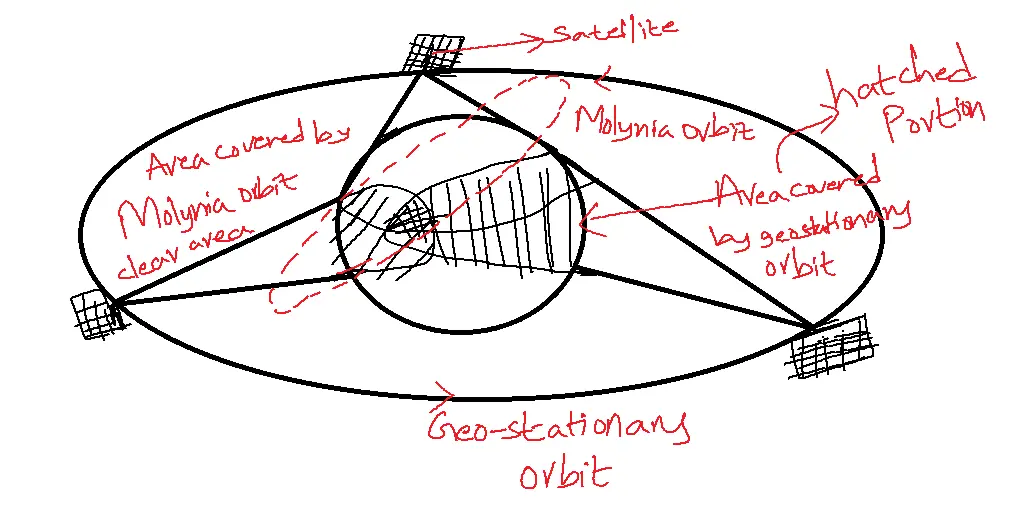Arthur C. Clarke first put forth Geo Synchronous orbit.
Geosynchronous Orbit revolves in a circle above the equator.
Geosynchronous orbit satellites orbit over the equator at 35,863 km (23000 miles) above the planet’s surface.
Table of Contents
What is Orbit?
A satellite’s orbit is the curved path it traces as it moves around the Earth.
The satellite’s velocity, or the speed at which it shifts in a straight line, and the force of the Earth’s gravitational pull on the satellite combine to form its orbit. These forces resemble those that maintain the positions of every planet in the solar system.
Classification of Orbits:
- The most basic orbit is a circular orbit.
- Utilizing inclined orbits is beneficial for covering equatorial regions.
- With three or four satellites in an elliptical orbit, quasi-stationary behavior can be observed from Earth.
- Satellite lifespans can be increased by altering their orbit.
In geostationary orbit, objects spin around the planet at the same speed as its rotation. This indicates that GEO satellites stay in the same location on the Earth’s surface.
About 2 degrees of angular spacing provides for 180 satellites.
Approximately 0.24 seconds for the round journey to the satellite.
An orbit must meet three requirements to be considered geostationary:
- The satellite is required to move eastward at the earth’s rotational speed.
- There must be a circular orbit.
- The orbit’s inclination needs to be at zero. (Orbit is located in the equatorial plane of Earth)

Advantages of Geosynchronous Orbit:
- Due to their apparent stationary position, GEOs do not require tracking.
- A GEO satellite may cover a sizable portion of the planet’s surface—nearly one-third—due to its great distance from the world.
- A small number of GEO satellites can provide coverage for most of the Earth’s surface.
- GEO satellites can observe a certain region around the clock.
- It is perfect for multipoint applications such as satellite broadcasting because of these reasons.
Disadvantages of Geosynchronous Orbit:
- Greater power is needed for communications on GEO satellites.
- The longer distances required for GEOs result in a lower signal-to-noise ratio.
- While the signal strength from a GEO satellite may be lower due to its distance and experience a slight time delay, its expansive coverage and continuous visibility make it ideal for broadcasting and certain data applications.
- GEO satellites struggle to transmit signals to areas close to the polar regions since they are positioned above the equator.
Applications of Geosynchronous Orbit
- Satellite Television (DTH): GEO satellites are ideal for broadcasting television signals directly to homes (DTH) due to their fixed position relative to the Earth. This ensures continuous coverage and stable reception for viewers.
- Satellite Radio: GEO satellites provide a reliable platform for broadcasting audio signals to large geographic areas. This enables the delivery of satellite radio services with consistent reception and wider coverage compared to terrestrial radio.
- VSAT Networks (Very Small Aperture Terminals): GEO satellites support VSAT networks, which provide internet and communication services to remote or underserved areas. VSAT terminals are relatively small and affordable, making them suitable for businesses, government agencies, and individuals in isolated locations.
- Weather Monitoring and Forecasting: Geostationary weather satellites continuously monitor Earth’s atmosphere, providing real-time data for weather forecasting, tracking storms, and predicting natural disasters. This information is crucial for meteorologists and emergency responders.
- Global Navigation Satellite Systems (GNSS): While not exclusively reliant on GEO, some GNSS augmentations, like the Wide Area Augmentation System (WAAS), use geostationary satellites to enhance the accuracy and reliability of GPS positioning. This is particularly important for aviation and precision navigation applications.
Related FAQs of Geosynchronous Orbit
1. What is a Geostationary Orbit (GEO)?
- Geostationary orbit is a circular orbit around Earth, approximately 35,786 kilometers (22,236 miles) above the equator, where a satellite’s orbital period matches Earth’s rotation. This makes the satellite appear stationary relative to a fixed point on the ground.
2. What are the advantages of using Geostationary Orbit for satellites?
- GEO offers continuous coverage of a specific region, making it ideal for broadcasting, telecommunications, and weather monitoring. It also simplifies ground station tracking and reduces the need for complex antenna systems.
3. What are the disadvantages of Geostationary Orbit?
- The high altitude of GEO leads to signal latency, which can be noticeable in real-time communication like video conferencing. GEO satellites are also expensive to launch and have limited capacity due to orbital slot constraints.
4. What types of satellites are typically placed in Geostationary Orbit?
- Common GEO satellites include communication satellites (for TV, radio, and internet), weather satellites, and navigation satellites (e.g., WAAS augmentation for GPS).
5. Are there alternatives to Geostationary Orbit for satellite communication?
- There are alternative orbits like Medium Earth Orbit (MEO) and Low Earth Orbit (LEO), each with advantages and disadvantages. MEO and LEO systems are gaining popularity for applications like broadband internet due to lower latency.
